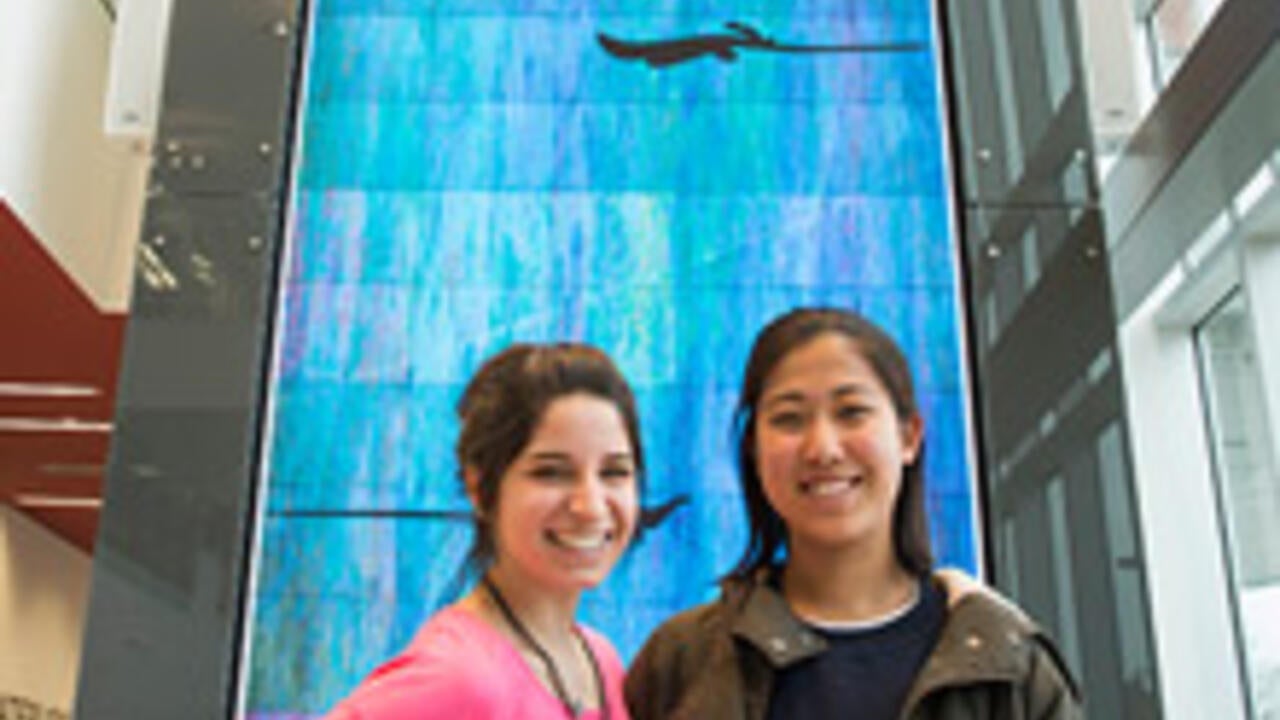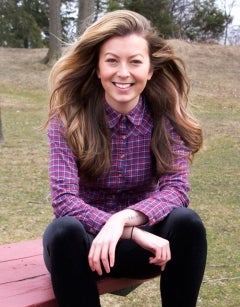
Landing a job in the digital economy with an arts degree
Find out how new Waterloo grads are launching their careers in the tech sector

Find out how new Waterloo grads are launching their careers in the tech sector
By Wendy Philpott Faculty of ArtsWhat can you do with an arts degree? New Waterloo arts grads say opportunities in the digital economy are growing for them as business leaders look for employees who can build bridges between technology and the people who use it.
Two graduates from the first cohort of Waterloo’s Global Business and Digital Arts (GBDA) program are launching their careers with giants of the digital tech sector.
Paula Barcante is jetting off to Amazon’s headquarters in Seattle to start her job as a UX designer on the Kindle Content Design team. And Kareen Mezerhane is landing in Toronto to work as a project manager with SapientNitro, a global digital marketing company.
For both, interning and experiential education was key to landing their new jobs, along with scholarship, applied digital and creative design, and experience with real-world business and tech projects.
 Paula Barcante
Paula Barcante Tell us about your new position at Amazon:
This month I will begin a full-time position as a UX Designer for Amazon, at their headquarters located in Seattle. My team focuses on the user experience of all the Kindle hardware and software. The job will include research into user needs, building wireframes and designing the user interface, and, of course, a lot of testing.
How did your internship prepare you for the job?
I actually held two internships at Amazon, the first one I secured on my own after 2nd year. In last summer’s GBDA internship with Amazon, I was a UX designer and researcher for Kindle. The objective was to combine three different Amazon publishing platforms into one that allows authors to understand their readers, sales, and marketing practices. GBDA taught me to dream big and think big in design, which was one of the greatest strengths that I brought to the internships. But at Amazon, I had to prove and defend every design decision. The design has to solve a problem.
How did the GBDA program prepare you for a career in tech?
I like to say that I am humanizing technology. The program provided me with diverse skills and concepts regarding digital media and business. The cool thing about GBDA is the fact that we are developing strategies, designs, and even concepts that have no limits. This is a creative thinking concept that not many other university programs have.
One skill GBDA excelled at was teaching its students to work in groups. Most of the tech industry today is organized in teams. This means most designers, marketers, project managers, developers will be working with a group of (usually) diverse individuals.
What advice do you have for students who want to study digital media?
With more and more technology taking over day to day tasks, the more it needs creative thinkers, psychologists, and humanists to understand how and why we use technology. My advice to students is to not focus so much on the job title you may think you want, but rather on what you enjoy doing. Be open minded and try as many different, weird, and difficult areas of digital media as possible. You will probably realize that what you thought you wanted to be in the beginning of your program will change drastically by the time you graduate… as long as you experiment and try new things.
 Kareen Mezerhane
Kareen Mezerhane Tell us about your new position at SapientNitro:
As a Jr. Program Manager I’ll be responsible for analyzing project requirements, breaking down tasks into smaller components for execution, ensuring day-to-day project objectives are met, monitoring, and tracking issues and risks. SapientNitro has an extensive client-base, including Hugo Boss, Coco-Cola, Ferrari, Footlocker and Target, so I will be managing projects in several different industries that range from website redesigns to creating multichannel digital platforms and global rebranding.
How did the GBDA program prepare you for the role?
As a project manager, it’s essential to have a well-rounded knowledge of art/technology, business, and operations. GBDA has given me that understanding, as well as the framework for project process. In the program, we used communication and collaboration software which taught us to effectively manage and conduct our final projects, especially during times when team members were in distant locations. SapientNitro is a global agency that constantly collaborates with experts from remote offices and locations, so it’s imperative for a project manager to have the ability to effectively communicate through virtual channels.
Tell us why studying digital media is important for a career in business.
The value of learning both arts and technology is extremely beneficial, especially in today’s society where everything is being translated digitally due to the exponential growth of technology. Also, the businesses of today and the future are constantly looking for ways to keep up with technology, and being able to understand both areas opens up endless possibilities for creativity and innovation.
How did global perspectives in the GBDA program impact your learning experience?
Joining other students from Canada and elsewhere to study digital media really opened my eyes. It felt as if we were in a global community without any borders. We are united through various forms of digital media, where we all possess a common knowledge on how to utilize it. And because we have different experiences and backgrounds, when working in teams, our ideas become more rich and developed. I believe that participating in this movement will further impact the way we view our world and the way we do business.
Paula Barcante image credit: Kevin Snider

Read more
A winter holiday message from President Vivek Goel

Read more
Researchers awarded funding to investigate ecology, climate change, repatriation, health and well-being through cultural and historical lens

Read more
Shop Canadian this holiday season with festive porch plants, fashion-forward apparel, craft spirits and more from Waterloo entrepreneurs
The University of Waterloo acknowledges that much of our work takes place on the traditional territory of the Neutral, Anishinaabeg, and Haudenosaunee peoples. Our main campus is situated on the Haldimand Tract, the land granted to the Six Nations that includes six miles on each side of the Grand River. Our active work toward reconciliation takes place across our campuses through research, learning, teaching, and community building, and is co-ordinated within the Office of Indigenous Relations.